| Columns Retired Columns & Blogs |
Enjoyable blog. Now I'll go back to reviewing this satellite/subwoofer set.

Once JA was all set-up, we got out of his way and let him work. Here’s what it looked like:

Here we see JA looking all hot and bothered, while the Magico Q5 waits on a dolly. By this point, John had already completed his in-room measurements. It took the three of us—me, John, and Mikey—to cajole the speaker onto the dolly and then carefully wheel it from Mikey’s listening room through his garage and into the driveway.
To a greater degree than any other loudspeaker in my experience, the Q5 does not like to be moved. Unlike other Magico speakers that are fashioned out of plywood and utilize front and rear baffles of aluminum, the Q5 is all aluminum and metal.

Even inside, the Q5 has a complex metal framework. Magico’s Irv Gross informs me that the speaker’s internal architecture consists of 86 plates and 377 bolts, though from the outside, all anyone can see are its 16 very serious-looking locking bolts. The thing is solid. Knock against its extremely dense cabinet, and you’re likely to hurt yourself. The speaker weighs almost 400 lbs, which is significantly more than the larger Acapella High Violoncello we worked with last week.
Because the Magico Q5 is too heavy for JA’s Outline speaker turntable, the dolly made good sense, allowing us to wheel the speaker around and position it just so.

John takes notes with a pink pen.
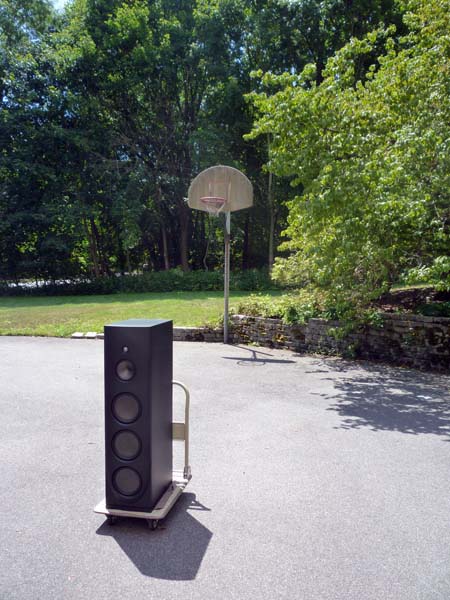
Hey, Q5, you’re open! Shoot the three! We set the Magico Q5 in the drive, away from any nearby boundaries or reflection points and away from the sun so that the speaker’s drivers wouldn’t bake. It was very hot out there.

This will feel a little uncomfortable, but only for a moment. I’m not sure what John is looking at here. I was going to make a rectal joke, but I don’t think it’s necessary. The speaker isn’t ported. Actually, I think John’s taking note of the serial number or something.
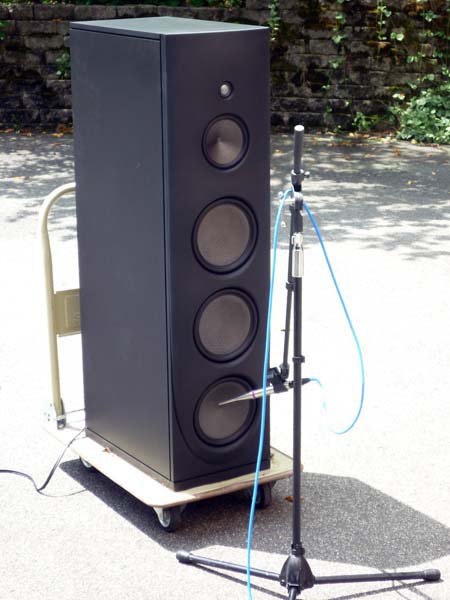
First, JA took the near-field response, starting with the bottom 9” woofer, what Magico calls a “Nano-Tec” driver.
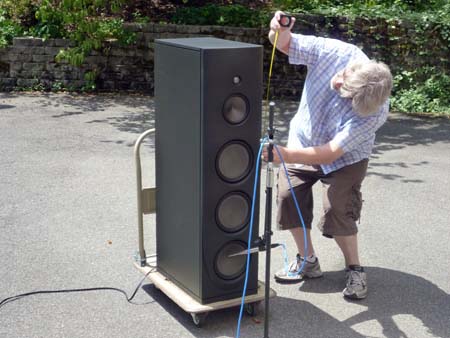
My, how you’ve grown, Q5.

Then, he worked his way up to the second woofer. (He did the same with the 9” mid-woofer, but I didn’t take a picture of it. You get the idea.)
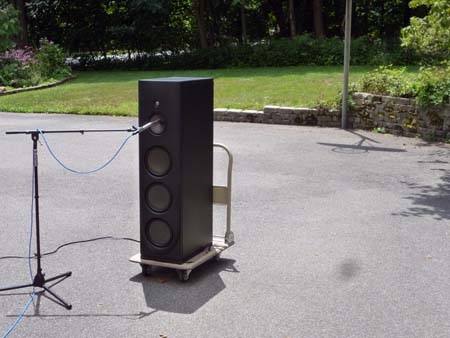
And, then, the 6” midrange “Nano-Tec” driver.

Here’s a close-up of the Q5’s 1” MBe-1 beryllium tweeter, claimed to be optimized for wide extension, low distortion, and excellent power handling.
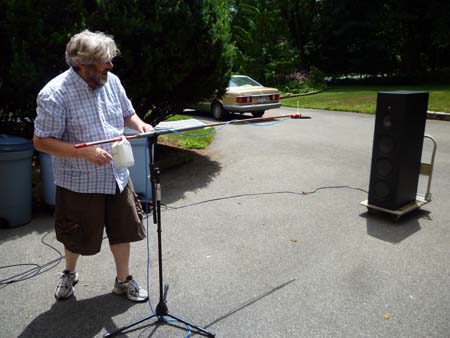
Next, JA prepared for his far-field tests.

Almost set.

John uses a small jug of lead shot as a ballast, keeping his mic set at the correct height.

Set.

Because we couldn’t utilize JA’s Outline speaker turntable, which is programmed to turn the speaker in five-degree increments, we used a simple protractor and rotated the speaker manually. Like men.

We used a long rule to mark our zero-degree starting point, then carefully rotated the speaker in five-degree increments.

Breathe in. John uses a stethoscope, also pink, and Faber Acoustical’s SignalSuite generator running on his iPod Touch to detect any abnormal cabinet resonances.

He carefully slides his thumb across the iPod Touch to sweep the signal while he listens closely.

And breathe out.

Now cough. After this last test, we packed up the measuring gear, slowly rolled the Q5 back into Mikey’s listening room, and had a heck of a time setting the speaker back into its original position. Did I mention that the Q5 doesn’t like to be pushed around?

Before "George/Carl/DUP" jumps in to ask why I wasn't using a proper mike stand for the farfield measurements, I use a long length of copper tube to hold the mike (balancd by the bottle of lead shot) so there won't be any significant reflections from the stand or its hardware any closer in time that the bounce of the speaker's sound from the nearest boundary (in this case the floor). I would have liked to have raised the Q5 off the floor to increase the length of the anechoic time window, but Stephen and Mikey weren't into that, for some reason :-)

"how do you know that where you put the mic is the best place to measure that particular driver? Or do u always put it exact center of the driver?"Exact center of the HF unit for farfield measurements; just to the side of the dustcap for nearfield."And certainly teh outside temperature is way out of range for a indoor speaker system, are the measurements legit then?"That's a good question. You can see that we faced the speaker away from the direct sun so that the drive-units were in the shade for the acoustic measurements.

Won't using a long hollow copper pipe cause potential resonances thus throwing off your measurements? I understand your concern about potential reflections off of a standard mic stand, but part of me wonders if you have traded one set of problems for another.

"Won't using a long hollow copper pipe cause potential resonances thus throwing off your measurements?"I haven't found any resonant effects from this tube affecting the measured speaker responses."Great photos and stories. It helps me to see the effort and approach needed to get the measurements."Thanks. It is safe to assume that every sentence you read in a Stereophile equipment report is based on much effort on the part of the reviewer. Which is why I get impatient when reviewers elsewhere appear to take short cuts: see my essay in the June issue: http://www.stereophile.com/asweseeit/as_we_see_it_ipad_daze/ .

At nearly 400 lbs, George, that's a lot of thermal mass.It will therefore take a long time for the structure as a whole to heat up, longer than the time we had the speaker in the driveway for measurement. (Note that as I am using a stethoscope, at the end of this period I was wold have been aware of any significant rise in the enclosure's temperature.) Also, at nearly 400 lbs, moving the speaker mandated the use of a dolly. In both cases, I felt that any impact on the measurements were outweighed by the advantages offered by measuring the speaker away from boundaries (other then the ground).

"I haven't found any resonant effects from this tube affecting the measured speaker responses." Meant to add that if you look closely at the tube in the photographs, you will see that I have warpaped duct tape around it at various places along its length. Together with the plastic sleeve at the stand clamp and the plastic bottle of lead shor hanging off it as a counterweight, this effectively kills any resonances in the copper material. There is still the air-space resonance with the tube, but as the tube is open at both ends, this will not be excited to any significant degree, I found.

John, there are some places you can get cheap(er) car parts, but 26 years IS pushing it.One of the other things you may consider for these Speaker measuring sojourns, is a particular thing called a motorcycle lift. You can get decently made ones with a flat bottom like a trolley cart, ones that look similar to the carts we use to bring our stuff into the various shows. However, this unit will have a foot activated and pumped hydraulic lift. Like a genie lift, of sorts, but hydraulic. About$500 for a decent one. Considering the value of some of the speakers that would be put on these tiny scissor lifts (consider renting from construction rental places before doing the measurements-1 day-$50) getting the best and most stable lift you can -might be prudent. Some of these lifts can go approx 6 feet up. Now that would really allow you to get into the midbass range, which would finally begin to be, shall we say... HIGHLY revealing.

The question was: where was I while JA and Stephen took care of the measurements.Well of course I was putting on Ebay all of the " audio stuff" you hallucinated was in my garage.Seriously, there was nothing I could do but stand around watching, or attend to other business while they worked, so of course i did other things, like have a back and forth with the designers of my website upgrade that hopefully will go live August 1st.BTW: I don't get to see the measurements before I write the review.

I was listening some hours to Magico's Q5 yesterday.
Q5 performed poorly compared to TAD's R1 and JBL's DD66000 Everest which are in the same price range.
My strongest advice is therefore: Go for TAD or JBL instead.
TAD Reference One:
http://tad-labs.com/en/consumer/reference_one/
JBL DD66000 Everest:
http://www.jbl.com/EN-US/Products/Pages/ProductDetails.aspx?PID=DD66000RW